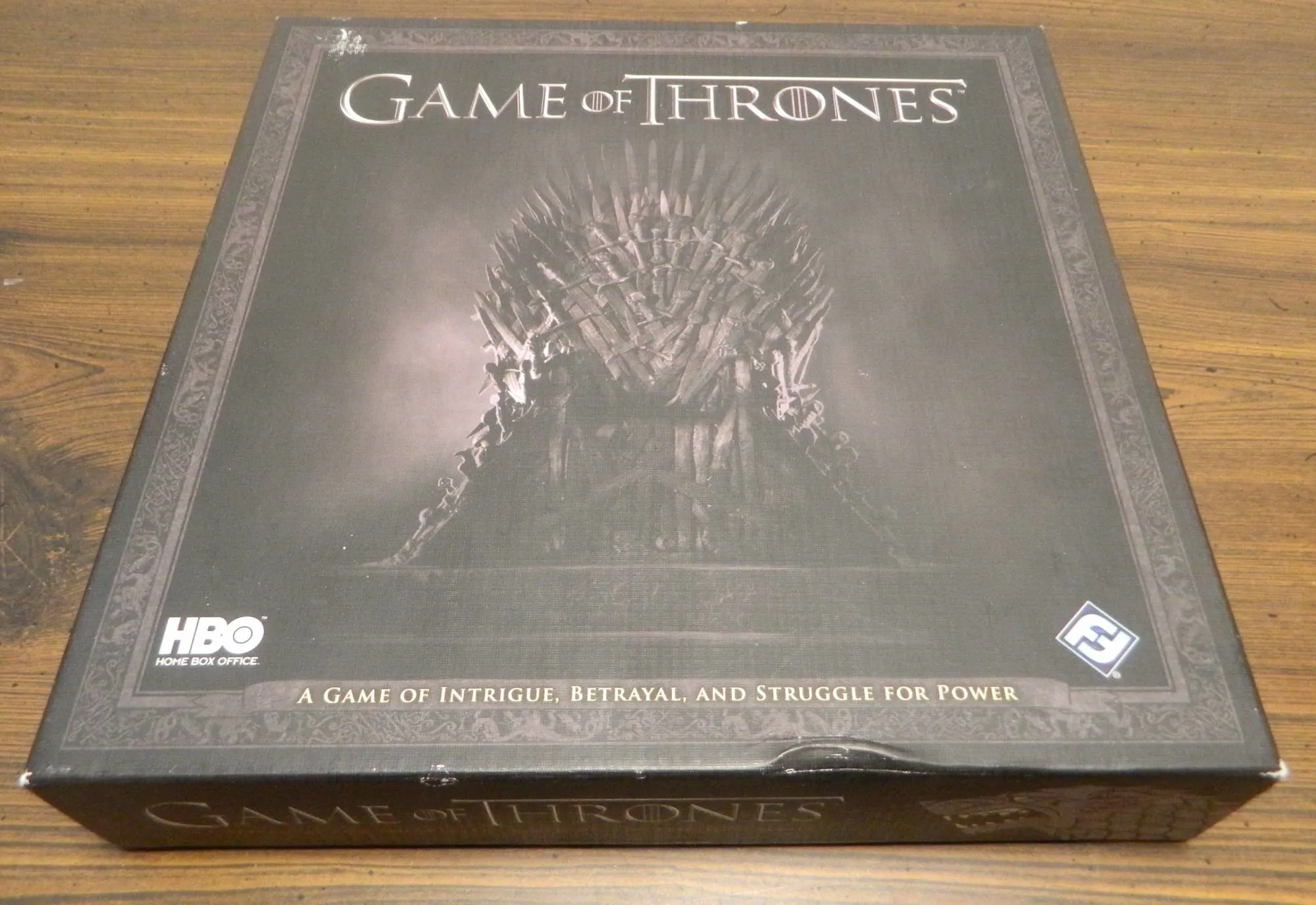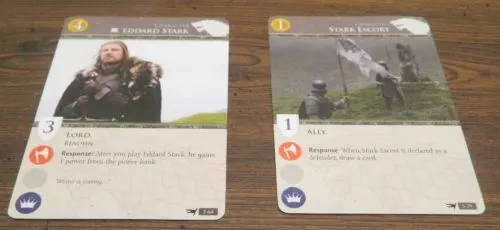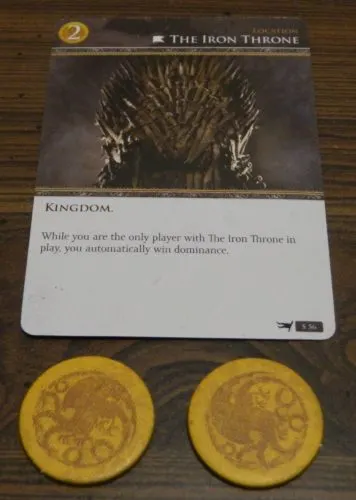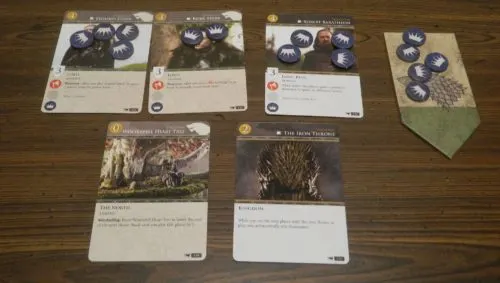This Sunday the final season of Game of Thrones begins and like most people I am quite excited. While I didn’t start watching the show until a couple of years after it first aired, it quickly became one of my favorite shows on television. To get hyped up for the show I decided to take a look at one of the Game of Thrones card games. It turns out that Game of Thrones has actually had quite a few card games (more on this later), but today I am looking at the 2012 version which focuses on the HBO show instead of the book series. Being a fan of Game of Thrones and card games in general, I was really interested in trying out Game of Thrones: The Card Game. Game of Thrones: The Card Game sometimes gets bogged down in too many nitpicky rules and a reliance on luck, but it succeeds at creating a good card game that does a great job utilizing the theme.
How to Play Game of Thrones: The Card Game
Anatomy of a Card
- Gold Cost (top left corner): The amount of gold a player has to pay to play the card.
- Title (top edge): The name of the card. Any card that features a banner symbol by the title is a unique card.
- House Symbol (top right corner): Indicates which house the card belongs to. Cards can either be House Stark, House Lannister, or a neutral house.
- Strength (left side below picture): The number indicates how powerful the card is in challenges.
- Challenge Icons (three icons along the bottom left corner): The icons showing indicate which challenges that the character may participate in. The three challenge icons are military (red axe), intrigue (green eye), and power (blue crown).
- Traits and Keywords (words under the picture): Characters can have three traits including Lord, Lady, and Knight which are referred in other cards. Cards may also have keywords. These keywords are Limited, Renown, and Stealth which have special effects.
- Card Ability (text): A paragraph/sentence describing the special ability of a card.
- Income Bonus: If a card has a large coin symbol in the description section, the player will receive the corresponding coins when the player receives their income at the beginning of their turn.
- Income Value (plot cards left number): The number on top of the coin determines how many coins the player will receive this turn.
- Initiative Value (plot cards middle number): This number is used to determine who will win initiative for the round.
- Claim Value (plot cards right number): This number indicates how much damage a player does when they are successful in a challenge as the attacker.
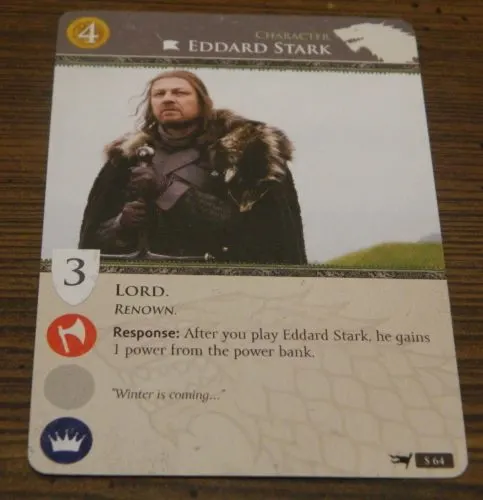
This character card has the following information. The card costs four gold to play. The character has three strength and can be used in military and power challenges. Eddard Stark is also a Lord, a unique card, and has Renown. You also will automatically add a power token to the card once it is played.
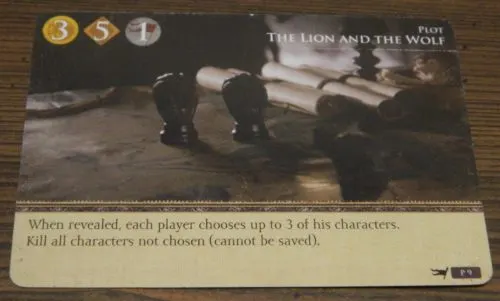
This plot card has the following information. This player will receive three coins as income this round. When determining who wins initiative, this card provides a value of five. Each successful challenge gives this player one of the associated reward. Finally the text along the bottom is applied when the card is played.
Types of Cards
The Game of Thrones Card Game has five different types of cards.
- Character Cards: Characters cards can be played during the “marshalling” phase. These cards can be used on offense and defense during challenges.
- Location Cards: Location cards can be played during the “marshalling” phase. These cards can be played in order to give players some sort of benefit.
- Attachment Cards: Attachment cards can be played during the “marshalling” phase. These cards are added to character cards giving them additional power/ability. When the attached character is removed for any reason, the attachment is discarded.
- Event Cards: Event cards can be played at any time unless mentioned otherwise. The card’s effect is applied and then the card is discarded.
- Plot Cards: Plot cards are unique cards. Each player plays one card each round and they give the player unique abilities.
Setup
- Sort all of the tokens by their type. Create a pile for the coins and the power tokens.
- The players choose their houses. One player will play as House Lannister and the other will play as House Stark. Each player takes the banner corresponding to the house they chose.
- Sort the cards by their backs.
- Each player will take the house deck corresponding to the house they chose. They will shuffle their deck.
- The players will each create their own plot deck. The players can choose to use a plot card draft (see below). Whether they chose to use a plot card draft or not, the players will take the following plot cards depending on which house they choose.
- House Lannister
- Detained
- Game of Thrones
- Hear Me Roar
- Securing the Throne
- The Killing Cold
- Uneasy Peace
- Valar Morghulis
- House Stark
- Calling the Banners
- Crossing the Trident
- Hidden in Shadows
- Spies in their Midst
- Storm of Swords
- The Lion and the Wolf
- The Old Gods
- House Lannister
- Each player will draw seven cards from their house deck. If the player doesn’t like the cards they have drawn, they may call one mulligan. If they choose to mulligan, they will shuffle the cards back into the deck and draw seven new cards.
- The players will then have the opportunity to place their starting cards. These starting cards are placed face down. Each player can play as many character and location cards as they want as long as they follow these rules:
- The cost of all of the cards can only add up to five or less.
- You can only play one card which has the word limited on it.
- You may not play attachment cards or duplicates of unique cards.
- When both players have chosen all of their starting cards, both players reveal their cards.
- Each player draws additional cards until they have a total of seven cards in their hand.
Playing the Game
Game of Thrones: The Card Game is played over a number of rounds. Each round consists of seven phases. Both players will complete the phase before you move onto the next phase. The seven phases of the game are as follows:
- Plot
- Draw
- Marshalling
- Challenges
- Dominace
- Standing
- Taxation
Plot
During the plot phase each player will chose one of their plot cards to play this round. These plot cards give players their money for the round as well as other benefits. When both players have chosen their plot cards, they are revealed at the same time. The chosen plot card is placed on top of any previously played plot cards.
The players compare the two plot cards that were played to determine who wins initiative. The player whose card has the higher initiative number, wins initiative. If there is a tie, the player with less power tokens on their banner and character cards will win initiative. The player who wins initiative decides who will be the first player this round.

The players have chosen these two plot cards for the round. The Old Gods card has higher initiative so that player gets to decide who will be the first player for the round.
If either of the plot cards chosen start with “when revealed”, their abilities are applied before moving onto the next phase.
Once a player has played all of their plot cards, they take all but the last played plot card back into their hand.
Draw
Each player draws two cards from their draw deck and adds them to their hand. If the player has no more cards left in their draw deck, they won’t draw more cards.
Marshalling
During the marshalling phase players will take turns taking actions. Before each player takes their first action they will determine their income for the round. A player’s income is equal to the income value on their chosen plot card along with the bonuses on cards played in front of them. They will take the corresponding number of coins from the bank.
The players will then take turns playing cards from their hands. To play a card the player has to pay coins to the bank corresponding to the gold cost of the card. This doesn’t apply to duplicate unique cards (see the Special Rules section). In addition to playing cards, players can use effects that apply during the marshalling phase.
After playing a card or taking an action, the other player gets to take an action or pass. The players can keep playing cards and taking actions until both players pass.
Challenges
In the challenges phase the players take turns, starting with the first player, challenging the other player. Note: The rules do contradict themselves on this point as it also states that a player completes all of their challenges before the other player declares their challenges. The players can perform three different types of challenges: military, intrigue, power. The players can perform all three challenges but can only do each challenge once.
When a challenge is declared the following steps are then taken:
- Declare Attackers
- Declare Defenders
- Resolve
The player who declared the challenge will first say which type of challenge they are initiating. They then can kneel (turn) as many character cards as they want to compete in the challenge that have the corresponding symbol. If a character is already knelt, they cannot be added to the challenge.
The defending player then has the ability to kneel characters to defend against the challenge. A character that is already knelt can’t aid in the defense. The player can choose not to defend but they must kneel at least one character or the attack will be declared undefended.
During each of the previous steps, players can use event cards to alter the challenge.
After all of the attackers and defenders have been declared, the challenge is resolved. Both sides add up the strength of their characters in the fight. If the defender’s strength is greater than the attacker, nothing happens as the defender was successful in their defense. If the attacking player’s strength is equal to or larger than the defender’s, the attacking player is successful in their challenge. The defending player will suffer a negative effect based on what type of challenge they lost.
- Military: The defending player must kill a number of their own characters (their choice) equal to the claim value on the other player’s current plot card.
- Intrigue: The defending player must discard, at random, cards from their hand equal to the claim value on the other player’s current plot card.
- Power: The defending player must move power tokens from their banner to the other player’s banner equal to the claim value on the other player’s current plot card.
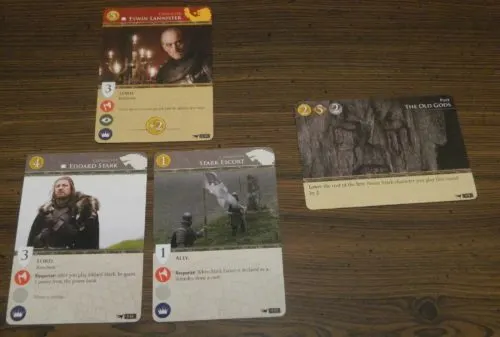
The Stark player has decided to use a military challenge. The Stark player knelt two characters with a combined strength of four (3+1). The Lannister player has decided to defend with one character with a strength of three. The Stark player has won the challenge. Based on the plot card the Stark player chose, the Lannister player has to kill off two of their characters.
If a player wins a challenge because it was undefended, the defending player will suffer the normal negative effect from the challenge. The attacking player will also get to take one power token from the bank and add it to their banner.
Dominance
At the beginning of the dominance phase each player counts up the strength of all of their standing characters (characters that are not kneeling). They will add their remaining coins to their total. The player with the higher total, will win dominance this round and add one power token to their banner. If the players are tied, neither player claims dominance this round.
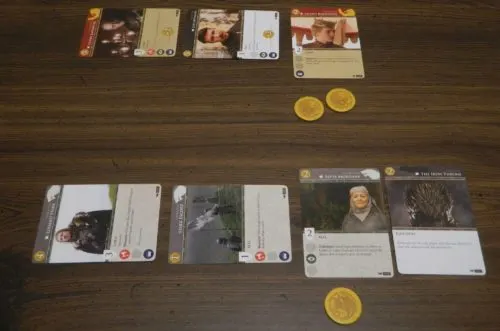
In this round the Stark player would win dominance as they are the only player to control the Iron Throne. If that card wasn’t in play, dominance would be determined as follows. The Lannister player has a total of four (two strength from the standing card and two coins). The Stark player has a dominance of three (two from the standing card and one coin). The Lannister player has won dominance and adds one power token to their banner.
Standing
All cards that have been knelt during the round, are stood back up.
Taxation
Players return all of the money they currently have to the bank. A new round is then played.
End of Game
The objective of the game is to acquire 15 power tokens. This includes power tokens on character cards and on your banner. When a player acquires 15 power tokens, they immediately win the game.
Special Rules
Here are some special rules regarding specific terms referenced in the game.
Dead Pile: There is a difference between the discard pile and the dead pile so the piles should be kept separate. When a character has been killed, they will remain dead. Any unique characters that are killed cannot be returned to the game at a later time. Some unique characters are in both decks though so each player has the opportunity to play that character even if the other person’s version of the character was already killed.
Unique Cards: Another special thing about unique characters is that only one of the cards can be present at a time. If a unique card is already in front of you and you have another of the card in your hand, you cannot play it as another character. Instead you can play the card as a duplicate which costs no coins. The card is placed behind the other card. This duplicate card can be discarded to save the character if they otherwise would be killed.
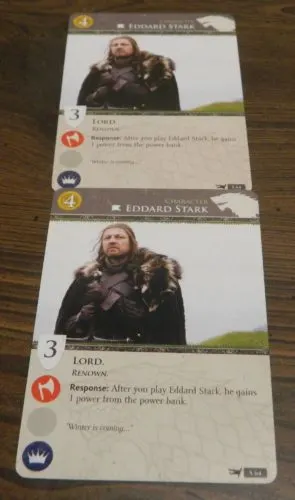
This player has played a duplicate Eddard Stark. The card will be placed behind the other card. When Eddard Stark otherwise would be killed, the player can discard the duplicate card.
Limited: Players can only play one card with the word limited on it each round.
Renowned: If a character that has renown is part of a challenge that is successful (either attacking or defending), they will add one power token to the card.
Stealth: When a stealth character is knelt for an attack, the player who knelt them can choose one of the other player’s characters who cannot be added to the challenge.
Plot Draft
If the players choose to use this variant in setup, they will begin by taking the seven cards mentioned in the setup section.
Of the cards not chosen, three are dealt to each player face down. The players look at these cards and choose which plot card they would like to take. They pass the other two cards to the other player. Each player then chooses one of these two plot cards to add to their set of plot cards. The other two cards are returned to the box. Players are then dealt three more cards and this process is repeated. This is continued until each player has thirteen plot cards.
The players will look at their thirteen cards and choose which seven cards they want to use in the game. The other cards are returned to the box.
My Thoughts Game of Thrones: The Card Game
So I am going to begin by saying that Game of Thrones: The Card Game doesn’t just share a name with the other Game of Thrones card games. It turns out that there has actually been quite a bit of development that lead into the 2012 game. The story begins in 2002 with the release of the Game of Thrones: Collectible Card Game. Like all collectible card games, this game had players purchase booster packs which gave you cards that you could use in the game. Eventually Fantasy Flight Games decided to move away from booster packs and moved towards living card games where you would purchase expansion packs instead of booster packs. This lead to the 2008 version of Game of Thrones: The Card Game. Finally in 2012 the game was once again redesigned in order to take advantage of the success of the HBO show bringing us to the game that I am talking about today.
So I will preface this by saying that I have not played either the 2002 or 2008 versions of the Game of Thrones: Card Game. After a little research though it appears that the 2012 version of the game is very similar to the earlier games. The 2012 version of the game seems to have three main differences from the 2008 version. First the game utilizes artwork from the television show instead of the books which lead to some of the cards being redesigned. The second difference is that the game was turned into a two player game. I don’t know if this was deliberate or if there was a plan to eventually release expansion packs.
The biggest difference between the 2012 and 2008 version of the game is that the 2012 version tried to streamline/simplify some of the mechanics from the previous games. This includes eliminating some of the less important mechanics and special keywords. This makes the game a little more approachable and easier to teach as there aren’t as many things that you have to keep track of.
With all of this said the 2012 Game of Thrones: The Card Game is still very similar to the previous two versions of the game. The main mechanics appear to basically be the same outside of a few tweaks. This means that if you have played one of the previous versions of the game, you already have a good idea of what to expect from the 2012 version of the game. Basically the 2012 version is a more streamlined/simplified version of the original game. If you liked the earlier games and want an easier version, I would consider picking up the 2012 version. If you don’t want a simpler game or didn’t care for the previous games, I don’t see any reason why the 2012 version would be any different.
Now that we have gotten all of these comparisons out of the way, lets get to talking about the game itself. The 2012 Game of Thrones: Card Game is similar and yet different from a lot of other card games. The premise is to acquire 15 power tokens. You accomplish this by using your money to purchase different cards. You then use these cards in order to initiate challenges which earns you power tokens or hurts your opponent in another way. The key to the game is figuring out how to best use your cards. In order to be successful in the game you need to analyze your cards and figure out how you can combine them. Being able to create a good combo of cards is really hard to stop.
Where Game of Thrones: The Card Game differentiates itself is that the game gives you three different avenues to attack the other player. The “combat” is exactly the same between the three types of challenges. Each type of challenge has a different effect on the game though. Military challenges let players kill the other player’s characters. Intrigue challenges can force your opponent to discard cards. Finally power challenges allow you to steal victory points from the other player. Having three different types of challenges give players options on how they want to attack the other player.
The other area where Game of Thrones: The Card Game differentiates itself is through the plot cards. The plot cards are used in order to give each player an unique ability each turn. What is interesting about the plot cards is that they can actually have a pretty big impact on the entire round. First they are the source for most of your money in a round. If the card doesn’t give you a lot of money, you likely won’t get to play a lot of cards this round. The cards also determine who is the first player for the round. Turn order can play a big role in what happens in the round. Finally the special ability that the plot card gives you has a big impact on how you and your opponent will approach the round. The plot card can either give you some sort of benefit or hurt the other player.
In addition to your typical card game mechanics, these unique mechanics create an interesting and fun card game experience. What I liked the most about the gameplay is that it gives you quite a few different ways to approach the game. You can focus on your military and eliminate the other player’s characters, or you could be a little sneakier and make them discard their cards or steal their victory points. Your strategy is going to depend on what cards you draw, but there is some flexibility as you can adjust your strategy by emphasizing different things. This makes it feel like you can have a real impact on the game.
Generally speaking licensed games are usually not that great. They usually slap the license onto a generic game and don’t put a lot of effort into tailoring the gameplay to fit the theme. This doesn’t feel like it is the case for Game of Thrones: The Card Game. It makes sense as this is basically the third iteration of a card game that was originally made when only the books existed. While the main gameplay could apply to other themes, care was put into tweaking the game in order to fully utilize the theme. For example the game’s two main factions are the Starks and the Lannisters. The Starks are mostly known as warriors while the Lannisters are more known for their cunning/treachery and their money. The game crafts the two decks to emphasize these traits. The Starks are better in combat while the Lannisters generally get more money and can manipulate things behind the scenes.
Overall I would say the components do a pretty good utilizing the theme as well. The cards themselves are nothing special as they are what you would expect out of a typical card game.The cards mostly utilize images from the television show. I thought the card design was pretty good though. The cards are designed in a way where it is easy to find whatever information you require. The cardboard tokens are also pretty good as they are pretty thick and the graphic design works well with the theme.
Another positive with the game is that it seems like the type of game where most games are going to be close until the very end. I see most games ending with the loser only being a couple power tokens away from winning themselves. This means that both players are in the game until the very end. Having a game where the players stay close until the very end is usually a really good sign for a game. It is not fun playing a game where you know way before the end who will ultimately win. In Game of Thrones: The Card Game players should feel like they are in the game until the very end.
I enjoyed my time with Game of Thrones: The Card Game but it has some issues.
I would say the biggest problem with the game is the fact that the game has quite a few nitpicky rules. Once you get used to playing the game it is pretty easy to understand. The game has a lot a little rules/quirks though which is a lot of grasp when you are playing the game for the first time. The game will probably take most people 10-15 minutes to teach to a new player. I could see it being a little overwhelming for people playing their first game as there are a lot of little things that you need to keep track of. This works itself out towards the end of your first game, but it is not the type of game that you can jump right into and know what you are doing.
The next biggest issue with the game is that like every card game there is quite a bit of reliance on luck. I would say that strategy is the biggest factor in determining who wins but luck is going to play a role as well. It doesn’t matter how good your strategy is if you don’t get the right cards. Luck is important because all of the cards are not created equally. Some cards are considerably better than others. The player who gets more of their good cards early in the game is going to win the game unless they make a terrible strategic decision. In particular you don’t want to fall behind in the number of character cards in front of you because your opponent will be able to win a lot more challenges as you won’t be able to defend and attack. If this happens it becomes pretty hard to catch up.
Another potential issue with the game is that it only supports two players. Outside of saving money by having to print less cards, I don’t know why the game couldn’t have supported four players. With only two houses though, there is no way to play the game with more than two players. The game is good as a two player game but I wish the game would have included the option to have more players. I am guessing this was somewhat unintentional as they were planning on creating expansions to add more houses to the game. I don’t know if the game didn’t sell well, but the game never got an official sequel so the game is capped at two players. There are quite a few sets made for other houses by the users on Board Game Geek though so if you are interested in adding more houses you can print out your own cards.
The final potential issue for the game is that the theme will play a pretty big role in your enjoyment of the game. If you aren’t a fan of the Game of Thrones series, I don’t know how much the game is going to appeal to you. It is a good card game but I don’t know how much of that is due to the theme. The game would still have been fun without the theme, but it would have struggled differentiating itself from other card games. Therefore if you aren’t a fan of Game of Thrones, I don’t know if you will really enjoy the card game.
Should You Buy Game of Thrones: The Card Game?
Game of Thrones: The Card Game is a game that has had a interesting history. It began as a collectible card game in 2002, was transformed into a living card game in 2008, and finally transformed into a more streamlined game in 2012. The 2012 Game of Thrones: The Card Game is pretty similar to the previous games except that it simplified some of the mechanics while implementing the theme from the television show. The game shares a lot in common with a lot of other card games, but at the same time has its own unique mechanics. The ability to use three different types of challenges along with the plot cards allow players to craft their own strategies giving players quite a bit of impact on the outcome of the game. The game also does a surprisingly good job implementing the theme as it actually impacts the gameplay in addition to the visuals. The game can be a little overwhelming at first though because it has quite a few nitpicky rules. It also relies on quite a bit of luck and I question how enjoyable the game will be for people who aren’t fans of the franchise.
If you don’t really care for card games or Game of Thrones, I don’t see Game of Thrones: The Card Game being for you. The decision for people who already own one of the previous versions of the game comes down to whether you want a more simplified version to play. If you are happy with one of the older versions of the game, I don’t really see the point in purchasing the 2012 version. If you have never played the other versions of Game of Thrones: The Card Game and enjoy the franchise, you should enjoy the game and I would recommend picking it up.
If you would like to purchase Game of Thrones: The Card Game you can find it online: Amazon, eBay

